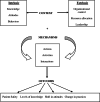Pressure injury prevention and management practices among nurses: A realist case study
- PMID: 30273984
- PMCID: PMC7948715
- DOI: 10.1111/iwj.13006
Pressure injury prevention and management practices among nurses: A realist case study
Abstract
The prevention and management of a pressure injury is a nurse-sensitive quality indicator in hospitals. Prevention and management of pressure injury practices have been found to be suboptimal despite the availability of interventions. Currently, there is a poor understanding of the mechanisms behind these interventions. The aim of the study was to explain a realistic portrayal of nurses' current practices to prevent and manage pressure injuries in one public hospital in Singapore. A realistic case study design was adopted. Twenty-four nurses were recruited. Audio-recorded interviews were transcribed verbatim to facilitate thematic analysis. Prevention and management was generally facilitated through the timely escalation of care, effective communication, support from the wound nurses, and bridging of the knowledge-practice gap. However, factors such as nurses' intrinsic characteristics and organisational support may affect the outcomes of these facilitators. Overall, nurses strive to achieve patient safety, where pressure injuries are prevented to the best of their abilities. This study provides causal links between contextual factors, mechanisms of the prevention and management, and the outcomes achieved. Further refinement and testing of the specific mechanisms are needed and will contribute to a better understanding of how nurses prevent and manage pressure injuries.
Keywords: case study; nurses; pressure injuries; qualitative; realistic evaluation.
© 2018 Medicalhelplines.com Inc and John Wiley & Sons Ltd.
Figures
References
-
- National Pressure Ulcer Advisory Panel . National Pressure Ulcer Advisory Panel (NPUAP) announces a change in terminology from pressure ulcer to pressure injury and updates the stages of pressure injury; 2016. http://www.npuap.org/national‐pressure‐ulcer‐advisory‐panel‐npuap‐announ.... Accessed February 23, 2018.
-
- Chan EY, Tan SL, Lee CK, Lee JY. Prevalence, incidence and predictors of pressure ulcers in a tertiary hospital in Singapore. J Wound Care. 2005;14(8):383‐384. 6‐8. - PubMed
-
- National Pressure Ulcer Advisory Panel, European Pressure Ulcer Advisory Panel, Pan Pacific Pressure Injury Alliance . Prevention and Treatment of Pressure Ulcers: Quick Reference Guide. Perth, Australia: Cambridge Media; 2014.
-
- Aslan A, Yavuz van Giersbergen M. Nurses’ attitudes towards pressure ulcer prevention in Turkey. J Tissue Viability. 2015;25(1):66‐73. - PubMed
MeSH terms
LinkOut - more resources
Full Text Sources
Medical
Miscellaneous


